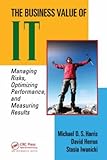The Business Value of IT: Managing Risks, Optimizing Performance and Measuring Results
In order to maximize IT resources and justify IT expenditures, CIO’s and other IT managers must be able to identify meaningful metrics and explain them in a way that management can understand. The Business Value of IT: Managing Risks, Optimizing Performance, and Measuring Results solves this problem by providing practical answers to these questions: What does IT contribute to the business? Why should we care about IT governance? How can we best measure IT performance? How do we mitigate the risks associated with change? Leading consultants Michael D. Harris, David E. Herron, and Stasia Iwanicki share their real-world experiences to explain how you can demonstrate IT’s value, and potentially find extra value you didn’t know your IT organization creates. They also show how to apply risk management to process improvement and avoid unintended consequences of process improvement programs. The text provides the understanding required to discover the processes necessary
List Price: $ 75.95
Price: $ 59.00
Check This:
 Six Sigma For Dummies
Six Sigma For DummiesThe world’s largest and most profitable companies – including the likes of GE, Bank of America, Honeywell, DuPont, Samsung, St…
 Six Sigma for Green Belts and Champions: Foundations, DMAIC, Tools, Cases, and Certification
Six Sigma for Green Belts and Champions: Foundations, DMAIC, Tools, Cases, and CertificationThis is the eBook version of the printed book.”Much has been said or written in recent times about the value of Six Sigma methodol…
 The Six Sigma Green Belt Handbook
The Six Sigma Green Belt HandbookThe Six Sigma Green Belt Handbook is a comprehensive, practical guide to becoming a Six Sigma Green Belt. Whether you’re just star…



Proving IT’s value to management,
Too often, companies suffer from strained relationships between their businesspeople and their information technology (IT) staffers. Much of this irritation stems from differences in the way they view IT’s contributions. Experienced IT executives Michael D.S. Harris, David Herron and Stasia Iwanicki’s useful handbook explains how to get IT team members and organizational personnel to understand each other, initially by clearly defining IT’s contributions in business terms. Besides valuable information, graphs, charts and chapter summaries, the authors include the references for everything they cite so you can dig more deeply into areas that affect your work. getAbstract praises their ability to express their thesis in human terms rather than lapsing into dreary technical recitations, although the writing is sometimes awkward. While utterly focused on IT, their book is not too technical for managers who deal with those in the field. This book enables you to explore the strengths and weaknesses of a variety of IT-finance, data and measurement models so you can select the ones that fit your situation.
Was this review helpful to you?

|